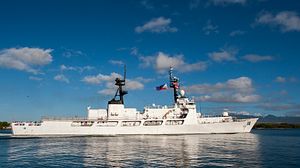On Wednesday, the Philippine government said that it had created a new task force to coordinate its policy on the South China Sea – which Manila calls the West Philippine Sea – amid rising tensions with China and ahead of a verdict on a case which it has filed against Beijing.
According to a document issued by the presidential office and seen by The Diplomat, the National Task Force for the West Philippine Sea (NTF-WPS) will be chaired by the national security adviser and consist of undersecretaries from 15 different agencies including foreign affairs, national defense, environment and natural resources, energy, trade and industry, transportation and communications, the military, the police and fisheries and aquatic resources. The body will essentially perform the functions of the current Inter-Agency Coordinating Committee.
“Given the country’s national interest, national policies, and evolving strategic landscape, a more deliberate and coherent approach in addressing the West Philippine Sea issue is needed for the purpose of orchestrating the national effort and achieving unified action in the West Philippine Sea,” Memorandum Circular No. 94, which was signed on March 17, reads.
Among the four Southeast Asian claimant states in the South China Sea, the Philippines has been bearing the brunt of growing Chinese assertiveness over the past few years, with Beijing seizing Scarborough Shoal from Manila following a three-month standoff back in 2012 and effectively enforcing what Philippine officials say is a de facto air defense identification zone (ADIZ) within which it routinely harassing ships, planes and fishermen (See: “China Enforcing Quasi-ADIZ in South China Sea: Philippine Justice”).
Last week, a Chinese coast vessel rammed the boat of Philippine fishermen in Scarborough Shoal, with Manila alleging that the fishermen had bottles thrown at them and Beijing claiming that the fishermen had retaliated with fire bombs. U.S. navy chief Admiral John Richardson also said last week that Washington had picked up activity around Scarborough Shoal that could be a precursor to Chinese land reclamation there (See: “US Submarine Visits Former Philippines Base Amid South China Sea Tensions”).
The recent move to better synchronize policy comes ahead of a much-anticipated verdict on a South China Sea case that the Philippines has filed against China at the Permanent Court of Arbitration (PCA) at the Hague, expected in May or June (See: “Does the Philippines’ South China Sea Case Against China Really Matter?”). Close observers of the Philippines’ South China Sea strategy have long noted that the lack of coordination between various agencies, including the coast guard and the navy.
In that vein, the document states that NTF-WPS will be responsible for “orchestrating and synchronizing” the employment of different national government agencies’ capabilities to achieve Philippine objectives in the South China Sea and in providing recommendations to outgoing Philippine president Benigno Aquino III and his successor following upcoming elections in May. The National Security Council will provide technical and administrative support, while the president will also provide guidance through the cabinet cluster on security, justice and peace.
The NTF-WPS will create an area-level task force (ATF) which will coordinate efforts between agencies at the area level. But it can also organize tactical-level task forces (TTFs) comprised of units, assets, capabilities and elements of different agencies.

































